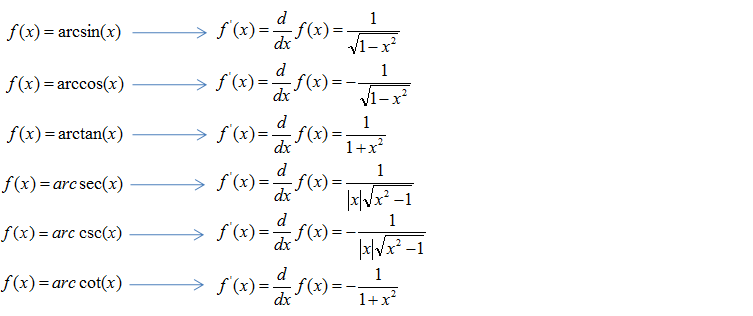Introduction to the derivative formula of inverse tangent function with proof to derive the differentiation of tan^-1(x) or arctan(x) in differential calculus. Find the Derivative - d/dx y=arctan(1/x) Differentiate using the chain rule, which states that is where. Tap for more steps. To apply the Chain Rule, set as. The derivative of with respect to is. Replace all occurrences of with. Differentiate using.
Formula
Find the first derivative of f(x) = arctan x + x 2 Solution to Example 2: Let g(x) = arctan x and h(x) = x 2, function f may be considered as the sum of functions g and h: f(x) = g(x) + h(x). Hence we use the sum rule, f '(x) = g '(x) + h '(x), to differentiate function f as follows f '(x) = 1 / (1 + x 2 ) + 2x = (2x 3 + 2x + 1) / (1 + x 2 ). SOLVED The partial derivatives of arctan(y/x) let w = arctan(y/x) the partial derivatives are: dw/dx and dw/dy i know that the derivative or arctan(x) is 1/(1+x^2). The Higher Derivatives Of The Inverse Tangent Function and Rapidly Convergent BBP-Type Formulas For Pi∗ Kunle Adegoke†, Olawanle Layeni‡ Received 8 April 2009 Abstract We give a closed formulafor the n-thderivative of arctanx. Anew self consistent expansion for arctanx is also obtained and rapidly convergent series for π are derived.
$dfrac{d}{dx}{, tan^{-1}{x}} ,=, dfrac{1}{1+x^2}$
Introduction

The inverse tangent function is written as $tan^{-1}{x}$ or $arctan{(x)}$ in inverse trigonometry, where $x$ represents a real number. The derivative of the tan inverse function is written in mathematical form in differential calculus as follows.
$(1) ,$ $dfrac{d}{dx}{, Big(tan^{-1}{(x)}Big)}$
$(2) ,$ $dfrac{d}{dx}{, Big(arctan{(x)}Big)}$
The differentiation of the inverse tan function with respect to $x$ is equal to the reciprocal of the sum of one and $x$ squared.

$implies$ $dfrac{d}{dx}{, Big(tan^{-1}{(x)}Big)}$ $,=,$ $dfrac{1}{1+x^2}$

Alternative forms
The differentiation of the tan inverse function can be written in terms of any variable. Here are some of the examples to learn how to express the formula for the derivative of inverse tangent function in calculus.
$(1) ,$ $dfrac{d}{dy}{, Big(tan^{-1}{(y)}Big)}$ $,=,$ $dfrac{1}{1+y^2}$
$(2) ,$ $dfrac{d}{dl}{, Big(tan^{-1}{(l)}Big)}$ $,=,$ $dfrac{1}{1+l^2}$
$(3) ,$ $dfrac{d}{dz}{, Big(tan^{-1}{(z)}Big)}$ $,=,$ $dfrac{1}{1+z^2}$
Proof
Learn how to derive the differentiation of the inverse tangent function from first principle.
DERIVATIVES OF INVERSE TRIGONOMETRIC FUNCTIONS
Differentiation of inverse trigonometric functions is a small and specialized topic. However, these particular derivatives are interesting to us for two reasons. First, computation of these derivatives provides a good workout in the use of the chain rule, the definition of inverse functions, and some basic trigonometry. Second, it turns out that the derivatives of the inverse trigonometric functions are actually algebraic functions!! This is an unexpected and interesting connection between two seemingly very different classes of functions.
It is possible to form inverse functions for restricted versions of all six basic trigonometric functions. One can construct and use an inverse cosecant function, for example. However, it is generally enought to consider the inverse sine and the inverse tangent functions. We will restrict our attention to these two functions.
Here are the results.

|
|

In order to verify the differentiation formula for the arcsine function, let us set
y = arcsin(x).
Derivative Of Arctanx/3
We want to compute dy/dx. The first step is to use the fact that the arcsine function is the inverse of the sine function. Among other things, this means thatDerivative Of Arccos
sin(y) = sin(arcsin(x)) = x.Next, differentiate both ends of this formula. We apply the chain rule to the left end, remembering that the derivative of the sine function is the cosine function and that y is a differentiable function of x.
| = |
| ||||||||
| = | 1 |
The next step is to solve for dy/dx. (After all, this is the thing that we want to compute!)
| = |
| = | sec(y) |
This looks like progress, but it is not the answer. Remember, when we differentiate a function of x in terms of x (this is the meaning of the dx in d/dx), we must express our answer in terms of x. Therefore the question remains.
If sin(y)=x, what is cos(y) in terms of x?
Derivative Of Arctan8x
The length of the third side of the reference triangle is determined by the Pythagorean Theorem.
12=x2+The last step is to express the trigonometric functions of y in terms of ratios of side lengths in the reference triangle. In particular, the secant of y is equal to the hypotenuse length divided by the adjacent side length.(third side)2 (third side)2 = 1-x2third side =sqrt(1-x2)
| = |
| = | sec(y) | = |
|
Derivative Of Arctan(4x)
This completes our study of differentiation for now. In Stage 6, we will investigate another general differentiation technique called implicit differentiation. Later still, we will learn how to differentiate exponential and logarithmic functions. For now, you should go to the Practice area and spend some time learning to use the many differentiation techniques that have been introduced in this Lesson. If there is one skill that we must develop for success in differential calculus, it is differentiation!! Enjoy, and good luck!!
If you find that you are having difficulty with differentiation, don't worry. You're not the first person to struggle with this technical skill. Contact your classmates. Discuss your difficulties. Contact your instructor. We can learn to do this!!
We now turn to the exponential and logarithmic functions. We have already discussed 'the' exponential function: exp(x)=ex. In order to differentiate the 'other' exponential functions and the logarithmic functions, we must first compute the derivative of the inverse to the exponential function. Thus we turn our attention to the natural logarithm.
| COVER | CQ DIRECTORY | HUB | CQ RESOURCES |
Derivative Of Arcsin
© CalculusQuestTM
Version 1
All rights reserved---1996
William A. Bogley
Robby Robson